2008 甘肃考研英语一真题及答案
Section I
Directions:
Use of English
Read the following text. Choose the best word(s) for each numbered blank and mark
A, B, C or D on ANSWER SHEET 1. (10 points)
The idea that some groups of people may be more intelligent than others is one of
those hypotheses that dare not speak its name. But Gregory Cochran is ___1___ to
say it anyway. He is that ___2___ bird, a scientist who works independently ___3___
any institution. He helped popularize the idea that some diseases not ___4___ thought
to have a bacterial cause were actually infections, which aroused much controversy
when it was first suggested.
___5___ he, however, might tremble at the ___6___ of what he is about to do. Together
with another two scientists, he is publishing a paper which not only ___7___ that
one group of humanity is more intelligent than the others, but explains the process
that has brought this about. The group in ___8___ are a particular people originated
from central Europe. The process is natural selection.
This group generally do well in IQ test, ___9___ 12-15 points above the ___10___
value of 100, and have contributed ___11___ to the intellectual and cultural life
of the West, as the ___12___ of their elites, including several world-renowned
scientists, ___13___. They also suffer more often than most people from a number
of nasty genetic diseases, such as breast cancer. These facts, ___14___, have
previously been thought unrelated. The former has been ___15___ to social effects,
such as a strong tradition of ___16___ education. The latter was seen as a (an)
___17___ of genetic isolation. Dr. Cochran suggests that the intelligence and
diseases are intimately ___18___. His argument is that the unusual history of these
people has ___19___ them to unique evolutionary pressures that have resulted in this
___20___ state of affairs.
1.
2.
3.
4.
5.
[A] selected
[B] prepared
[C] obliged
[D] pleased
[A] unique
[B] particular
[C] special
[D] rare
[A] of
[B] with
[C] in
[D] against
[A] subsequently
[B] presently
[C] previously
[D] lately
[A] Only
[B] So
[C] Even
[D] Hence
�
6.
7.
8.
[A] thought
[B] sight
[C] cost
[D] risk
[A] advises
[B] suggests
[C] protests
[D] objects
[A] progress
[B] fact
[C] need
[D] question
[A] attaining
9.
[D] calculating
[B] scoring
[C] reaching
[A] normal
10.
11.[A]unconsciously [B]disproportionately [C]indefinitely
[B] common
[C] mean
[D] total
[D] unaccountably
[A] missions
12.
careers
[B] fortunes
[C] interests
[D]
13.
[A] affirm
[B] witness
[C] observe
[D] approve
14.
[A] moreover
[B] therefore
[C] however
[D] meanwhile
15.
[A] given up
[B] got over [C] carried on
[D] put down
16.
[A] assessing
[B] supervising
[C] administering
[D] valuing
17.
[A] development
[B] origin
[C] consequence
[D] instrument
18.
[A] linked
[B] integrated
[C] woven
[D] combined
19.
[A] limited
[B] subjected
[C] converted
[D] directed
20.
[A] paradoxical
[B] incompatible
[C] inevitable
[D] continuous
Reading Comprehension
Section II
Part A
Directions:
Read the following four texts. Answer the questions below each text by choosing A,
B, C or D. Mark your answers on ANSWER SHEET 1. (40 points)
Text 1
While still catching-up to men in some spheres of modern life, women appear to be
way ahead in at least one undesirable category. “Women are particularly susceptible
to developing depression and anxiety disorders in response to stress compared to
�
men,” according to Dr. Yehuda, chief psychiatrist at New York’ s Veteran’ s
Administration Hospital.
Studies of both animals and humans have shown that sex hormones somehow affect the
stress response, causing females under stress to produce more of the trigger
chemicals than do males under the same conditions. In several of the studies, when
stressed-out female rats had their ovaries (the female reproductive organs) removed,
their chemical responses became equal to those of the males.
Adding to a woman ’ s increased dose of stress chemicals, are her increased
“opportunities” for stress. “It’s not necessarily that women don’t cope as well.
It’s just that they have so much more to cope with,” says Dr. Yehuda. “Their capacity
for tolerating stress may even be greater than men’s,” she observes, “it’s just
that they’re dealing with so many more things that they become worn out from it
more visibly and sooner.”
Dr. Yehuda notes another difference between the sexes. “I think that the kinds of
things that women are exposed to tend to be in more of a chronic or repeated nature.
Men go to war and are exposed to combat stress. Men are exposed to more acts of random
physical violence. The kinds of interpersonal violence that women are exposed to
tend to be in domestic situations, by, unfortunately, parents or other family members,
and they tend not to be one-shot deals. The wear-and-tear that comes from these longer
relationships can be quite devastating.”
Adeline Alvarez married at 18 and gave birth to a son, but was determined to finish
college. “I struggled a lot to get the college degree. I was living in so much
frustration that that was my escape, to go to school, and get ahead and do better.”
Later, her marriage ended and she became a single mother. “It’s the hardest thing
to take care of a teenager, have a job, pay the rent, pay the car payment, and pay
the debt. I lived from paycheck to paycheck.”
Not everyone experiences the kinds of severe chronic stresses Alvarez describes.
But most women today are coping with a lot of obligations, with few breaks, and
feeling the strain. Alvarez’s experience demonstrates the importance of finding
ways to diffuse stress before it threatens your health and your ability to function.
21.
Which of the following is true according to the first two paragraphs?
[A] Women are biologically more vulnerable to stress.
[B] Women are still suffering much stress caused by men.
[C] Women are more experienced than men in coping with stress.
[D] Men and women show different inclinations when faced with stress.
�
22.
Dr. Yehuda’s research suggests that women
[A] need extra doses of chemicals to handle stress.
[B] have limited capacity for tolerating stress.
[C] are more capable of avoiding stress.
[D] are exposed to more stress.
23.
According to Paragraph 4, the stress women confront tends to be
[A] domestic and temporary.
[B] irregular and violent.
[C] durable and frequent.
[D] trivial and random.
The sentence “I lived from paycheck to paycheck.” (Line 6, Para. 5) shows
24.
that
[A] Alvarez cared about nothing but making money.
[B] Alvarez’s salary barely covered her household expenses.
[C] Alvarez got paychecks from different jobs.
[D] Alvarez paid practically everything by check.
25.
Which of the following would be the best title for the text?
[A] Strain of Stress: No Way Out?
[B] Responses to Stress: Gender Difference
[C] Stress Analysis: What Chemicals Say
[D] Gender Inequality: Women Under Stress
Text 2
It used to be so straightforward. A team of researchers working together in the
�
laboratory would submit the results of their research to a journal. A journal editor
would then remove the authors’ names and affiliations from the paper and send it
to their peers for review. Depending on the comments received, the editor would
accept the paper for publication or decline it. Copyright rested with the journal
publisher, and researchers seeking knowledge of the results would have to subscribe
to the journal.
No longer. The Internet – and pressure from funding agencies, who are questioning
why commercial publishers are making money from government-funded research by
restricting access to it – is making access to scientific results a reality. The
Organization for Economic Co-operation and Development (OECD) has just issued a
report describing the far-reaching consequences of this. The report, by John
Houghton of Victoria University in Australia and Graham Vickery of the OECD, makes
heavy reading for publishers who have, so far, made handsome profits. But it goes
further than that. It signals a change in what has, until now, been a key element
of scientific endeavor.
The value of knowledge and the return on the public investment in research depends,
in part, upon wide distribution and ready access. It is big business. In America,
the core scientific publishing market is estimated at between $7 billion and $11
billion. The International Association of Scientific, Technical and Medical
Publishers says that there are more than 2,000 publishers worldwide specializing
in these subjects. They publish more than 1.2 million articles each year in some
16,000 journals.
This is now changing. According to the OECD report, some 75% of scholarly journals
are now online. Entirely new business models are emerging; three main ones were
identified by the report ’ s authors. There is the so-called big deal, where
institutional subscribers pay for access to a collection of online journal titles
through site-licensing agreements. There is open-access publishing, typically
supported by asking the author (or his employer) to pay for the paper to be published.
Finally, there are open-access archives, where organizations such as universities
or international laboratories support institutional repositories. Other models
exist that are hybrids of these three, such as delayed open-access, where journals
allow only subscribers to read a paper for the first six months, before making it
freely available to everyone who wishes to see it. All this could change the
traditional form of the peer-review process, at least for the publication of papers.
26.
In the first paragraph, the author discusses
[A] the background information of journal editing.
[B] the publication routine of laboratory reports.
�
[C] the relations of authors with journal publishers.
[D] the traditional process of journal publication.
27.
Which of the following is true of the OECD report?
[A] It criticizes government-funded research.
[B] It introduces an effective means of publication.
[C] It upsets profit-making journal publishers.
[D] It benefits scientific research considerably.
28.
According to the text, online publication is significant in that
[A] it provides an easier access to scientific results.
[B] it brings huge profits to scientific researchers.
[C] it emphasizes the crucial role of scientific knowledge.
[D] it facilitates public investment in scientific research.
29.
With the open-access publishing model, the author of a paper is required to
[A] cover the cost of its publication.
[B] subscribe to the journal publishing it.
[C] allow other online journals to use it freely.
[D] complete the peer-review before submission.
30.
Which of the following best summarizes the text?
[A] The Internet is posing a threat to publishers.
[B] A new mode of publication is emerging.
[C] Authors welcome the new channel for publication.
[D] Pub lication is rendered easier by online service.
Text 3
�
In the early 1960s Wilt Chamberlain was one of only three players in the National
Basketball Association (NBA) listed at over seven feet. If he had played last season,
however, he would have been one of 42. The bodies playing major professional sports
have changed dramatically over the years, and managers have been more than willing
to adjust team uniforms to fit the growing numbers of bigger, longer frames.
The trend in sports, though, may be obscuring an unrecognized reality: Americans
have generally stopped growing. Though typically about two inches taller now than
140 years ago, today’s people – especially those born to families who have lived
in the U.S. for many generations – apparently reached their limit in the early 1960s.
And they aren’t likely to get any taller. “In the general population today, at
this genetic, environmental level, we’ve pretty much gone as far as we can go,”
says anthropologist William Cameron Chumlea of Wright State University. In the case
of NBA players, their increase in height appears to result from the increasingly
common practice of recruiting players from all over the world.
Growth, which rarely continues beyond the age of 20, demands calories and nutrients
– notably, protein – to feed expanding tissues. At the start of the 20th century,
under-nutrition and childhood infections got in the way. But as diet and health
improved, children and adolescents have, on average, increased in height by about
an inch and a half every 20 years, a pattern known as the secular trend in height.
Yet according to the Centers for Disease Control and Prevention, average height –
5′9″ for men, 5′4″ for women – hasn’t really changed since 1960.
Genetically speaking, there are advantages to avoiding substantial height. During
childbirth, larger babies have more difficulty passing through the birth canal.
Moreover, even though humans have been upright for millions of years, our feet and
back continue to struggle with bipedal posture and cannot easily withstand repeated
strain imposed by oversize limbs. “There are some real constraints that are set
by the genetic architecture of the individual organism,” says anthropologist
William Leonard of Northwestern University.
Genetic maximums can change, but don’t expect this to happen soon. Claire C. Gordon,
senior anthropologist at the Army Research Center in Natick, Mass., ensures that
90 percent of the uniforms and workstations fit recruits without alteration. She
says that, unlike those for basketball, the length of military uniforms has not
changed for some time. And if you need to predict human height in the near future
to design a piece of equipment, Gordon says that by and large, “you could use today’
s data and feel fairly confident.”
31.
Wilt Chamberlain is cited as an example to
[A] illustrate the change of height of NBA players.
�
[B] show the popularity of NBA players in the U.S..
[C] compare different generations of NBA players.
[D] assess the achievements of famous NBA players.
32.
Which of the following plays a key role in body growth according to the text?
[A] Genetic modification.
[B] Natural environment.
[C] Living standards.
[D] Daily exercise.
33.
On which of the following statements would the author most probably agree?
[A] Non-Americans add to the average height of the nation.
[B] Human height is conditioned by the upright posture.
[C] Americans are the tallest on average in the world.
[D] Larger babies tend to become taller in adulthood.
34.
We learn from the last paragraph that in the near future
[A] the garment industry will reconsider the uniform size.
[B] the design of military uniforms will remain unchanged.
[C] genetic testing will be employed in selecting sportsmen.
[D] the existing data of human height will still be applicable.
35.
The text intends to tell us that
[A] the change of human height follows a cyclic pattern.
[B] human height is becoming even more predictable.
[C] Americans have reached their genetic growth limit.
�
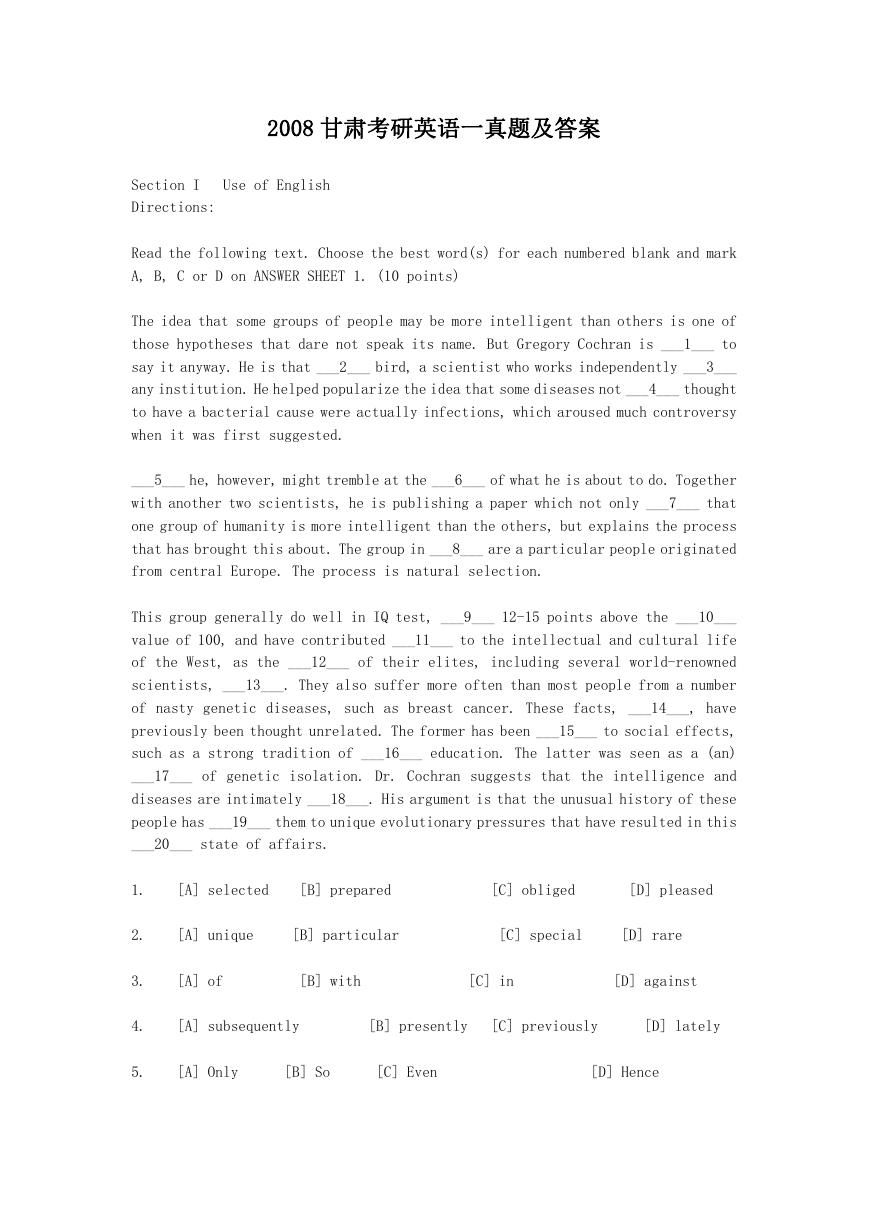
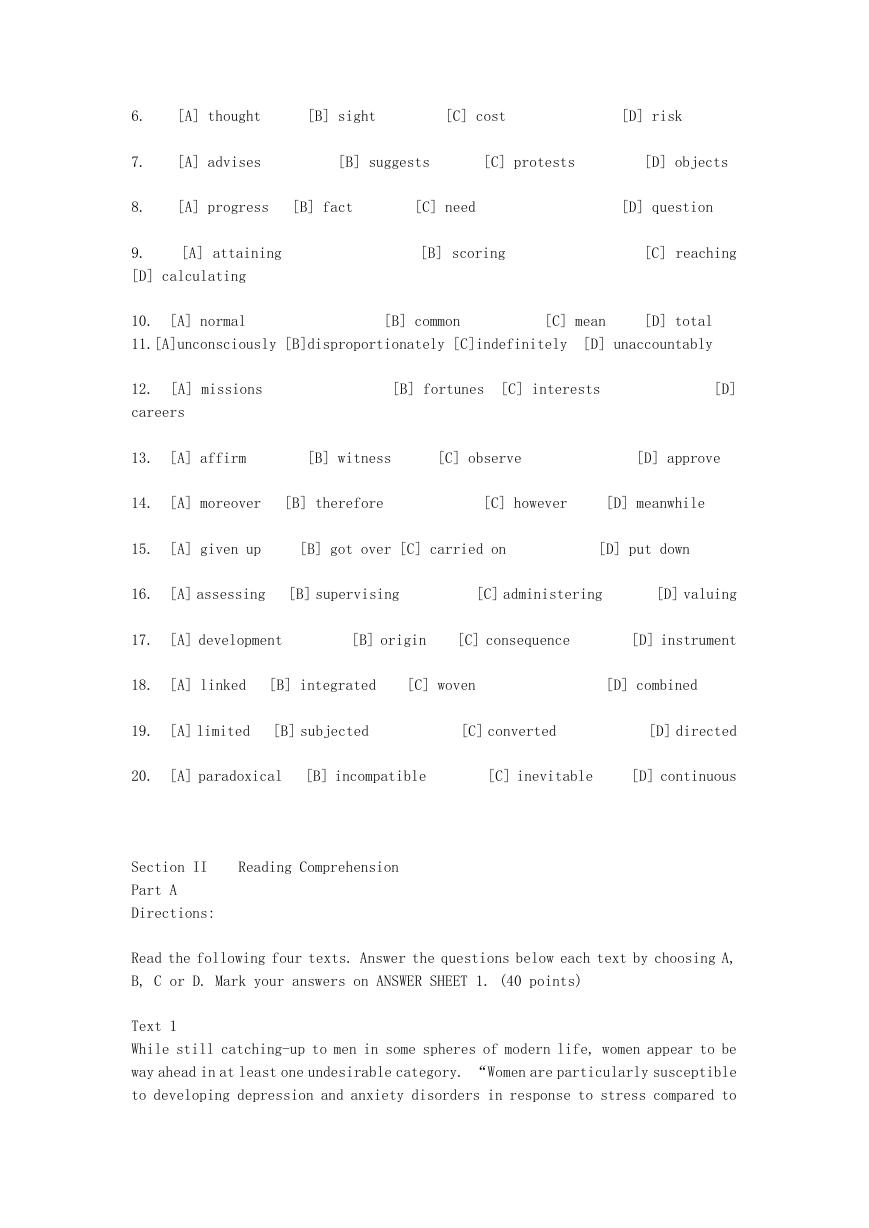
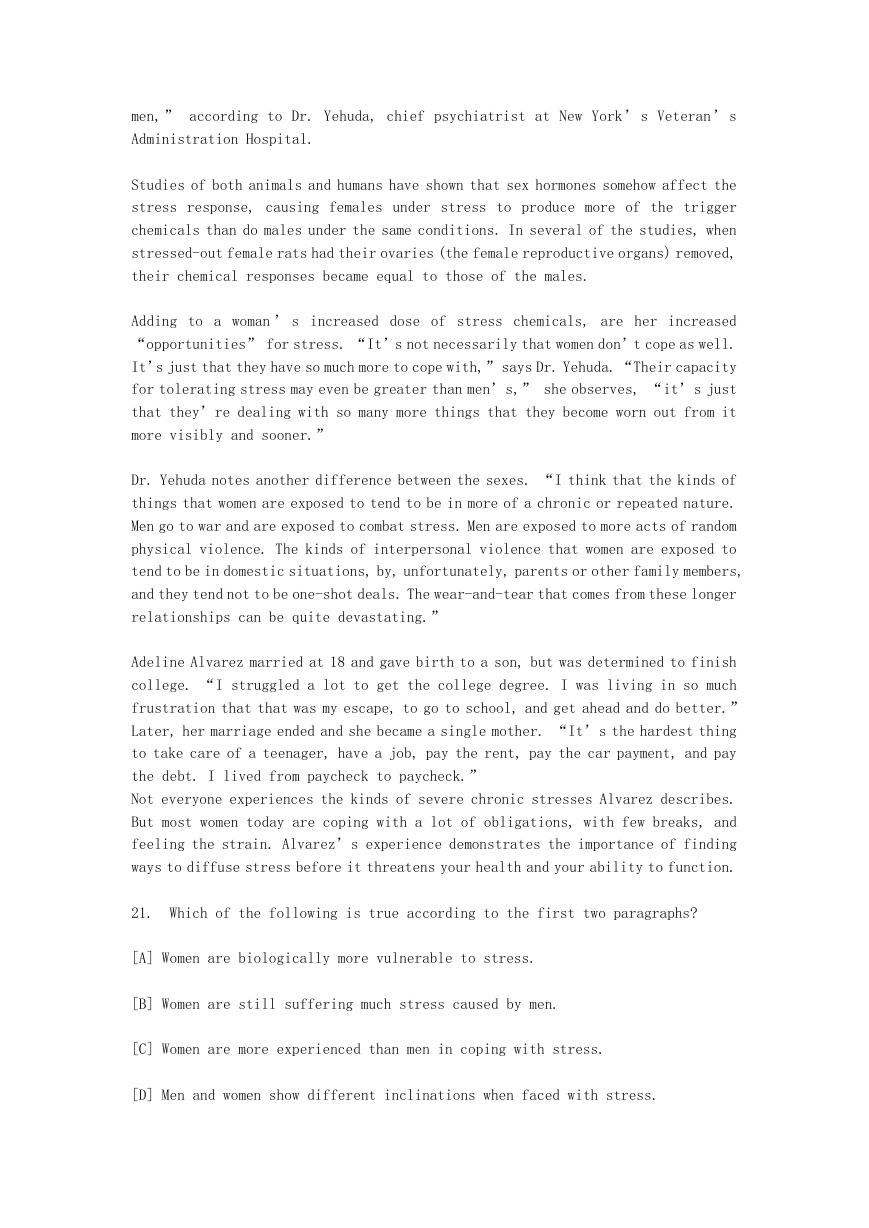
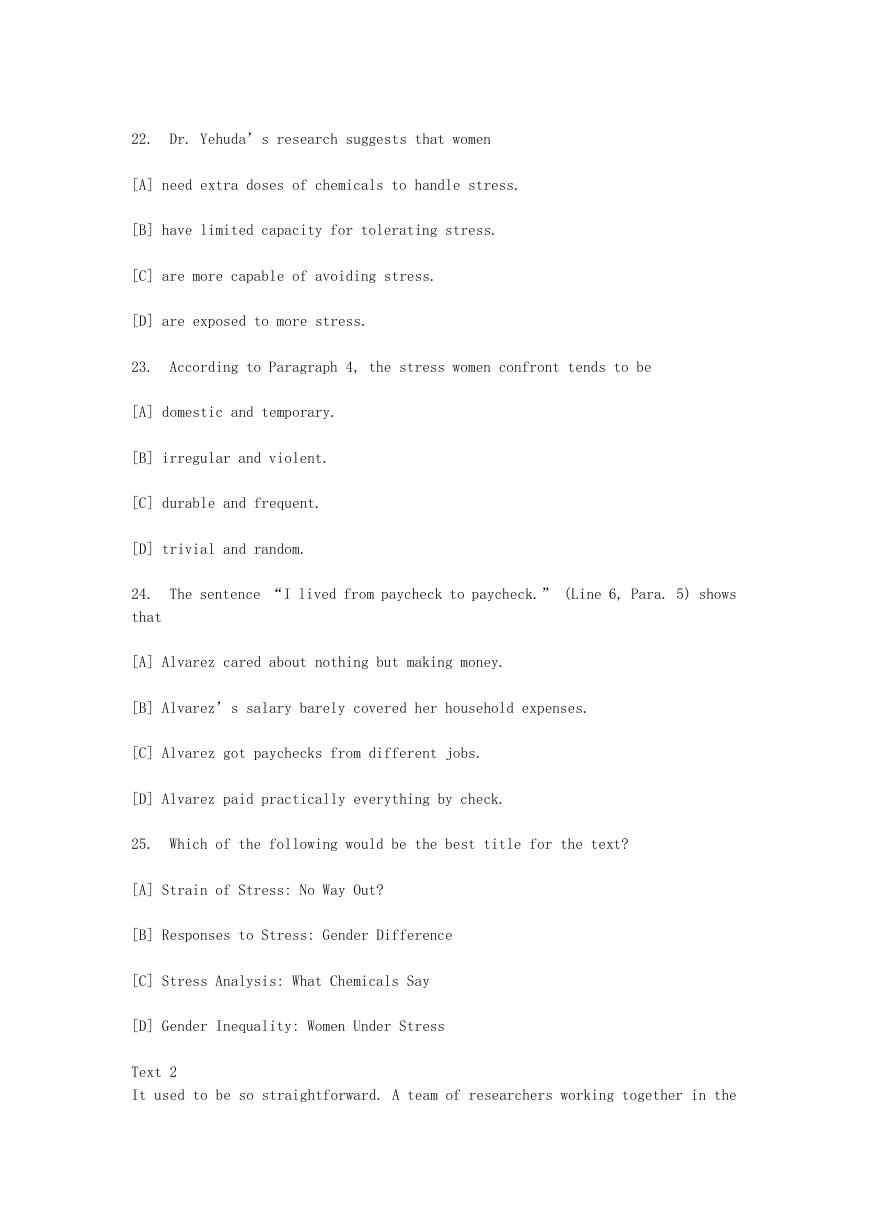
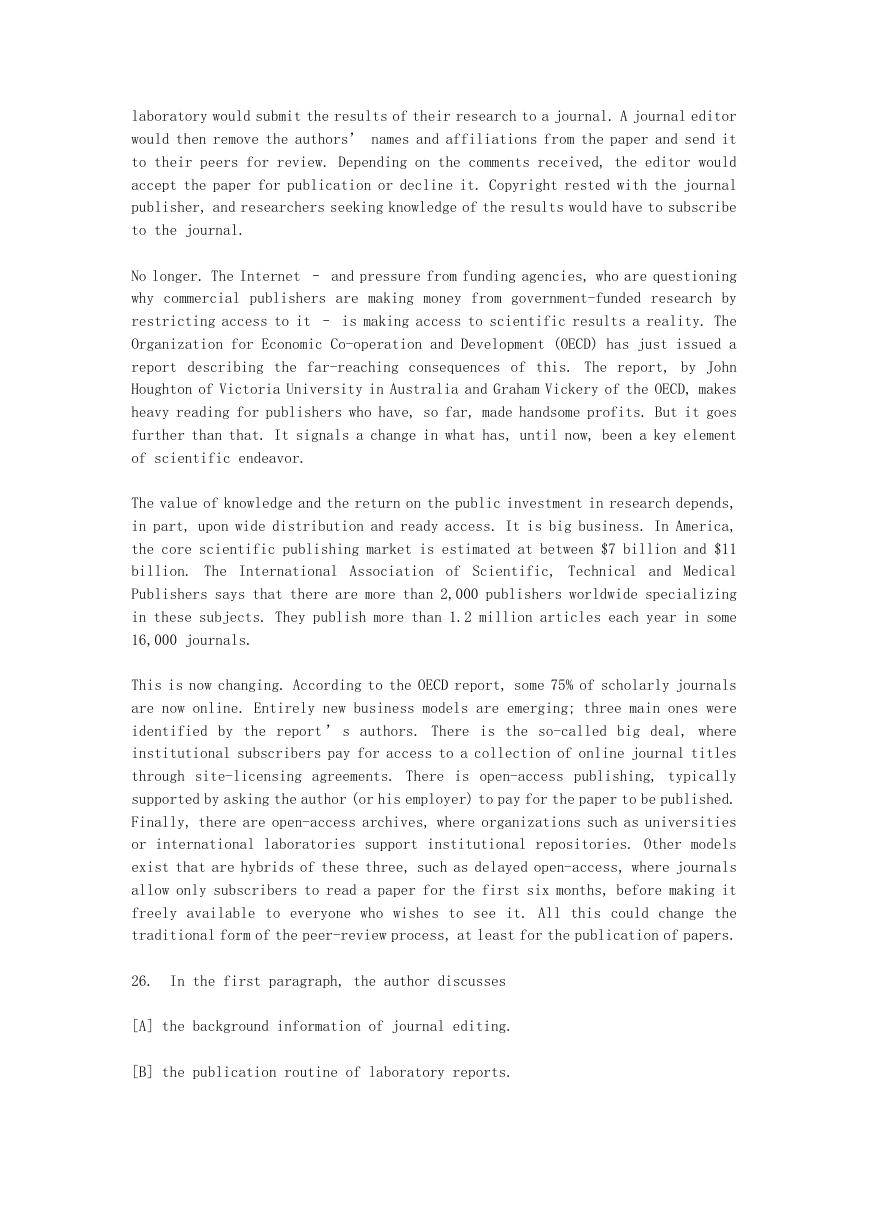

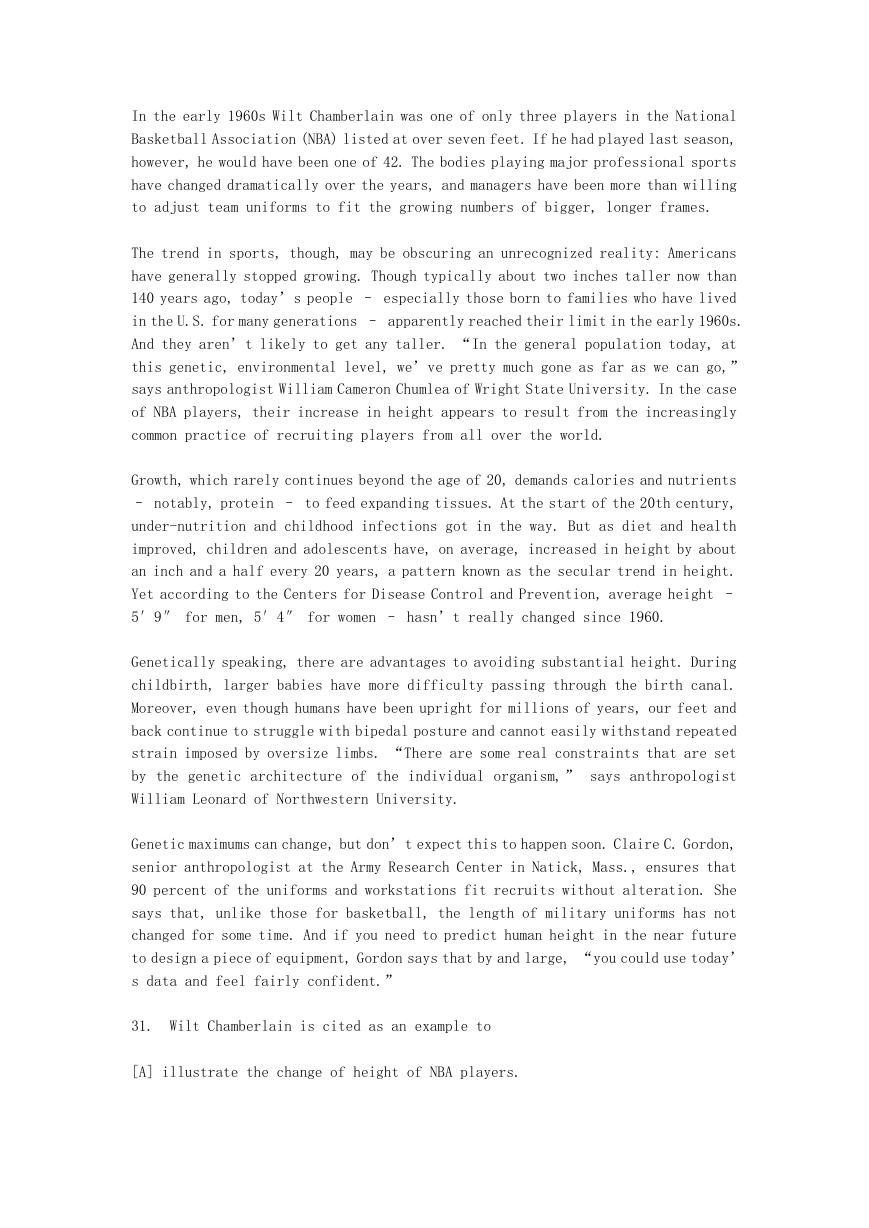
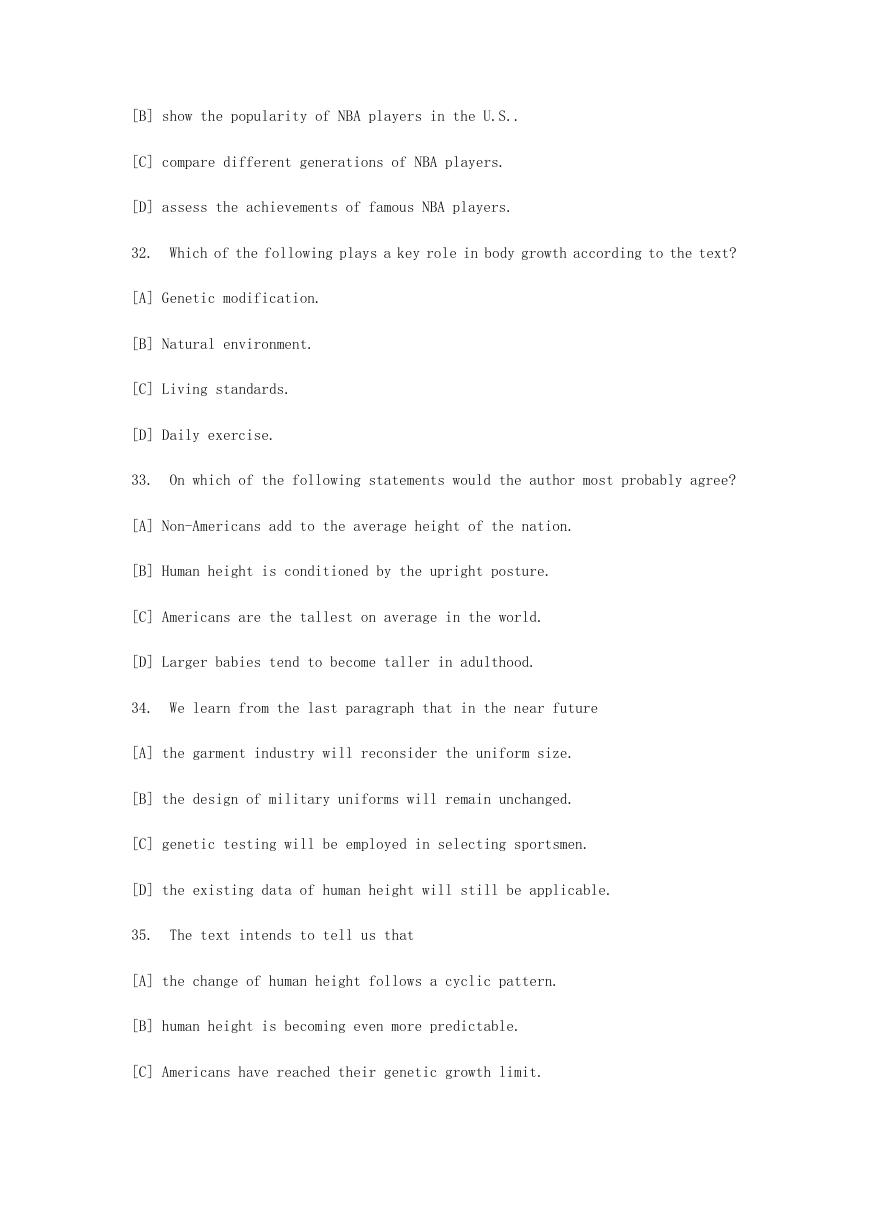








 2023年江西萍乡中考道德与法治真题及答案.doc
2023年江西萍乡中考道德与法治真题及答案.doc 2012年重庆南川中考生物真题及答案.doc
2012年重庆南川中考生物真题及答案.doc 2013年江西师范大学地理学综合及文艺理论基础考研真题.doc
2013年江西师范大学地理学综合及文艺理论基础考研真题.doc 2020年四川甘孜小升初语文真题及答案I卷.doc
2020年四川甘孜小升初语文真题及答案I卷.doc 2020年注册岩土工程师专业基础考试真题及答案.doc
2020年注册岩土工程师专业基础考试真题及答案.doc 2023-2024学年福建省厦门市九年级上学期数学月考试题及答案.doc
2023-2024学年福建省厦门市九年级上学期数学月考试题及答案.doc 2021-2022学年辽宁省沈阳市大东区九年级上学期语文期末试题及答案.doc
2021-2022学年辽宁省沈阳市大东区九年级上学期语文期末试题及答案.doc 2022-2023学年北京东城区初三第一学期物理期末试卷及答案.doc
2022-2023学年北京东城区初三第一学期物理期末试卷及答案.doc 2018上半年江西教师资格初中地理学科知识与教学能力真题及答案.doc
2018上半年江西教师资格初中地理学科知识与教学能力真题及答案.doc 2012年河北国家公务员申论考试真题及答案-省级.doc
2012年河北国家公务员申论考试真题及答案-省级.doc 2020-2021学年江苏省扬州市江都区邵樊片九年级上学期数学第一次质量检测试题及答案.doc
2020-2021学年江苏省扬州市江都区邵樊片九年级上学期数学第一次质量检测试题及答案.doc 2022下半年黑龙江教师资格证中学综合素质真题及答案.doc
2022下半年黑龙江教师资格证中学综合素质真题及答案.doc